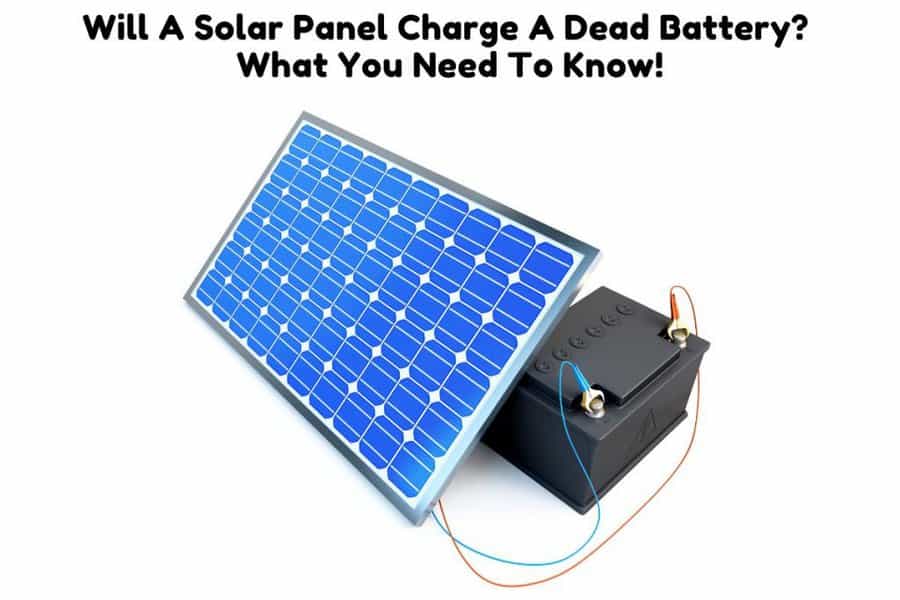Combining solar panels with batteries can reduce dependence on fossil fuel-generated electricity. A solar panel can be used to charge any rechargeable battery including dead ones as long as it’s a functioning battery.
Battery technology stretches back to 1798 when the first battery was invented. Today batteries are an indispensable part of life used in everything from mobile devices to electric vehicles.
In this article, we show you how to charge a dead battery with a solar panel. We also look at different battery types and characteristics as well as what they mean when you are using solar and batteries together.

How Do You Charge A Battery With A Solar Panel?
A battery can be charged with a solar panel in two ways. If the solar panel has a power rating of 5 watts or less it can be connected directly to the battery. If the solar panel is rated at more than 5 watts then a charge controller should be used to connect the solar panel to the battery.
On a side note! If you’re in need of a reliable and high-performance portable solar panel, We strongly recommend the Jackery SolarSaga 100W Portable Solar Panel (Amazon Link).
With a high conversion efficiency and foldable design, this solar panel is easy to transport and set up, making it perfect for outdoor activities like camping, hiking, and RV trips.

The US solar cell technology used in this panel ensures that you get the most efficient and reliable solar charging possible.
There is also a 60W option that is more affordable (Amazon Link)
There are three main types of batteries that are most commonly used for solar applications. These are lithium, flooded lead acid, and sealed lead acid batteries. They each have a few unique characteristics you should know when using them with solar panels. Source
Lithium batteries
Lithium batteries are a popular choice for solar systems because they have a deeper depth of discharge than lead acid batteries. Depth of discharge (DOD) is an important characteristic of a battery. It tells you how much of a battery’s capacity you can safely use before you need to recharge it.
Lithium batteries have a depth of discharge of 80%. This means you can use 80% of the battery’s capacity before you recharge it. For example, if a battery has a capacity of 100Ah, then you would use 80Ah before recharging it with your solar panels.
Flooded lead acid batteries
Flooded lead acid batteries are an older battery technology than lithium. These are the batteries you find in your car. They are called flooded or wet batteries because they use a liquid electrolyte, typically sulphuric acid. Source
Flooded lead acid batteries have a depth of discharge of 50%. This means if your battery has a capacity of 100Ah, you can use 50Ah before you should recharge it.
Sealed lead acid batteries
Sealed lead acid batteries are a type of lead acid battery. Unlike flooded lead acid batteries, the sulphuric acid in a sealed lead acid battery is immobilized as a gel or encased in fiberglass. This is why sealed lead batteries are called dry batteries.
Sealed lead acid batteries have a depth of discharge of 50%. Draining a battery beyond its depth of discharge will damage the battery by reducing its capacity at a faster rate. This means a 100Ah battery will store less than 100Ah over time if you continually exceed its depth of discharge.
Factors to Consider When Charging A Battery Using Solar Panels
To charge any of these batteries using a solar panel you have to consider the capacity of your battery, the size of your solar panel, and the amount of sunlight your solar panels will receive. These factors determine whether you need a charge controller and how long it will take to charge your battery.
The capacity of your batteries
Battery capacity is typically rated in amp hours or Ah. If you have a 100Ah battery that means your battery has a capacity of 100-amp hours. You can draw 1 amp for 100 hours or 20 amps for 5 hours.
Size of the solar panels
The size of the solar panels is their power rating in watts. Watts is how much power a solar panel produces and this can range anything from 1 watt to newer panels that produce a whopping 600 watts.
The more powerful the solar panel is, the quicker it will charge a battery. The power rating also determines whether a charge controller is necessary. Charge controllers regulate the voltage and current going into a battery.
Without a charge controller, you run the risk of overcharging and damaging the battery. Use a charge controller if your solar panel has a power rating of more than 5 watts.
Hours of sunlight
The more peak sun hours you have, the more solar energy there is at your disposal. If you get fewer sun hours, for example, if you live in a state like Alaska or if it’s winter, it will take longer to charge your battery than if you live in Arizona or if it’s summer.
You can find out how many peak sunlight hours your home receives from Google’s Sunroof Project. Source
How Long Does It Take A Solar Panel To Charge A Car Battery?
The length of time taken to charge a car battery with a solar panel depends on the capacity of the battery, the power rating of the solar panel, and the number of peak sunlight hours available. The higher the power rating and sunlight hours are, the less time it will take to charge the battery.
Internal combustion engines or gas-powered vehicles have batteries with an average capacity of about 48Ah. An electric vehicle battery capacity can be anything from 20 kWh to 100 kWh. Depending on the voltage, a Tesla Model S uses 450 volts, that’s 44.4Ah to 222.2Ah.
To calculate how long it would take to charge your gas-powered or electric car you would need to know the power rating of your solar panel and your peak sun hours. Let’s say you receive 5 hours of peak sunlight and you have 5 different solar panels rated at various capacities, here is how long it would take to charge a 50Ah battery.
| SOLAR PANEL SIZE (WATTS) | HOURS TO CHARGE |
|---|---|
| 50 | 12 |
| 100 | 6 |
| 150 | 4 |
| 200 | 3 |
| 250 | 2.4 |
Can A 100W Solar Panel Charge A Car Battery?
A 100W solar panel can charge a car battery if the solar panel has a higher voltage than the battery. Car batteries are rated at 12V. A charge is carried from high to low voltage. For a solar panel to charge a car battery it has to have a voltage of 12V or higher.
Can I Charge A Car Battery Directly From A Solar Panel?
Directly charging a car battery from a solar panel is possible if the solar panel has a power rating below 5 watts. If the solar panel produces more than 5 watts, then a charge controller should be used.
